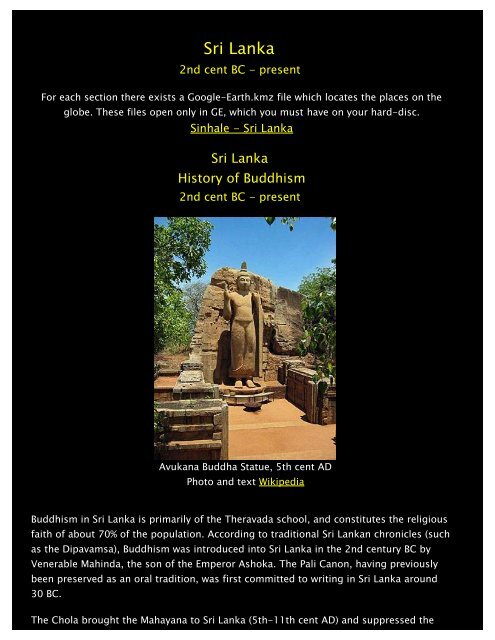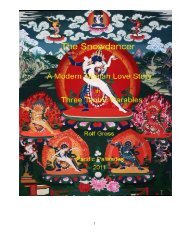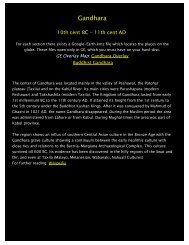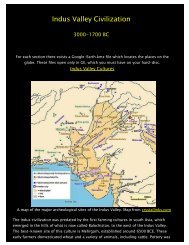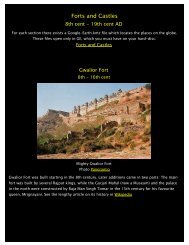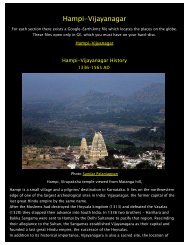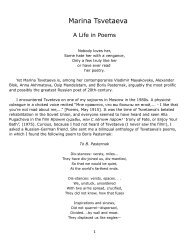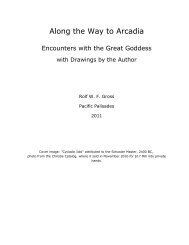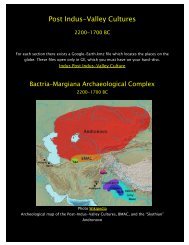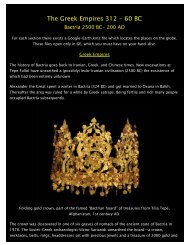Sri Lanka - Rolf Gross
Sri Lanka - Rolf Gross
Sri Lanka - Rolf Gross
- No tags were found...
You also want an ePaper? Increase the reach of your titles
YUMPU automatically turns print PDFs into web optimized ePapers that Google loves.
<strong>Sri</strong> <strong>Lanka</strong>2nd cent BC - presentFor each section there exists a Google-Earth.kmz file which locates the places on theglobe. These files open only in GE, which you must have on your hard-disc.Sinhale - <strong>Sri</strong> <strong>Lanka</strong><strong>Sri</strong> <strong>Lanka</strong>History of Buddhism2nd cent BC - presentAvukana Buddha Statue, 5th cent ADPhoto and text WikipediaBuddhism in <strong>Sri</strong> <strong>Lanka</strong> is primarily of the Theravada school, and constitutes the religiousfaith of about 70% of the population. According to traditional <strong>Sri</strong> <strong>Lanka</strong>n chronicles (suchas the Dipavamsa), Buddhism was introduced into <strong>Sri</strong> <strong>Lanka</strong> in the 2nd century BC byVenerable Mahinda, the son of the Emperor Ashoka. The Pali Canon, having previouslybeen preserved as an oral tradition, was first committed to writing in <strong>Sri</strong> <strong>Lanka</strong> around30 BC.The Chola brought the Mahayana to <strong>Sri</strong> <strong>Lanka</strong> (5th-11th cent AD) and suppressed the
Theravada monasteries. TheTheravda lineage was only revived in the 13th-15th centthrough contact with Myanmar and Thailand. Official neglect under colonial rule, createdgreat challenges for Theravada Buddhist institutions in <strong>Sri</strong> <strong>Lanka</strong>. During the 19th centrevivals and resurgences have kept the Theravada tradition aliveOnly three of the many sites are included here.Reference H.R. Perera, accesstoinsight.orgAnuradhapura <strong>Sri</strong> <strong>Lanka</strong>3rd cent ADThis is a UNESCO Heritage site. The citation says:“This sacred city was established around a cutting from the 'tree of enlightenment, theBuddha's fig tree, brought there in the 3rd century B.C. by Sanghamitta, the founder ofan order of Buddhist nuns. Anuradhapura, a Ceylonese (sic!) political and religiouscapital that flourished for 1,300 years, was abandoned after an invasion in 993 is nowaccessible once again.” Text UNESCOAnuradhapura, Thuparama Stupa, 3rd cent ADPhoto PanoramioThuparama Stupa in which was enshrined the collarbone of the Buddha is considered tobe the first dagoba built in <strong>Sri</strong> <strong>Lanka</strong> following the introduction of Buddhism. The dagabawas destroyed from time to time. During the reign of King Agbo II it was completelydestroyed and restored. What we have today is a reconstruction of the dagaba.
The columns sourrounding it are remnants of a "vatadage", a cupola (19 th cent?)) thatoriginally surrounded the stupa as shown in the model below. Such a structure couldonly have been built in the 13th-14th cent by Isalmic architects. Domes of this kind areunknown in India before the 19 th cent..Model of the “roof” structure, "vatadage”, Photo and text WikipediaAnuradhapura, Jetavanaramaya Stupa3rd cent ADJetavanaramaya Stupa in Anuradhapura, <strong>Sri</strong> <strong>Lanka</strong>.Photo PanoramioKing Mahasena (273-301 AD) initiated the construction of the stupa. The largest brickstupa which rivals the Great Pyramids of Giza in size. The stupa has recently been freedof overgrowth - but not white-washed yet - so that the brick structure is visible.
Nalanda Gedige3rd cent - 11th cent ADNalanda Gedige in <strong>Sri</strong> <strong>Lanka</strong> appears to be a Theravada, Mahayana and Tantric sanctuaryof the 3rd cent - 10th century AD in <strong>Sri</strong> <strong>Lanka</strong>. It was brought to my attention by JanakaBandara. New photos by Radek Scibior (private communication 2008) allow a betterguess at the date and origin of the structuresVery little is known about this site. An inspection of the GE map shows two structures: acircular stupa and a rectangular temple.The circular building turns out to be an early Buddhist brick stupaof the 2 nd or 3rd cent AD,The rectangular structure is a temple, named after Nalanda ,India, (9 th cent). It is made of locallime stone and appears to date from the 9th or 10th cent (also related to Chola temples). It's
external sculpture, heavily weathered, is decidely Tantric. It may well be late MahayanaBuddhist but might also be Shaivite Tantric temple.A Buddha,and a Tantric sculptureon the outside of the temple, 10-11 th centuryThe intriguing question is that this site lies in Shri <strong>Lanka</strong> which originally (2nd cent BC -5th cent AD) was Theravada Buddhist. <strong>Sri</strong> <strong>Lanka</strong> was partially converted to the Mahayanaby the Chola in the 5th cent AD and in the 13th cent it was reconverted to the Theravadaby missionaries from Southeast Asia. - If Buddhist this would be one of the rare Tantricsites known on the subcontinent and their most southern one.My thanks go to Radek Scibior, who contributed the photos. I would appreciate anycomments from knowledgable archeologists.


